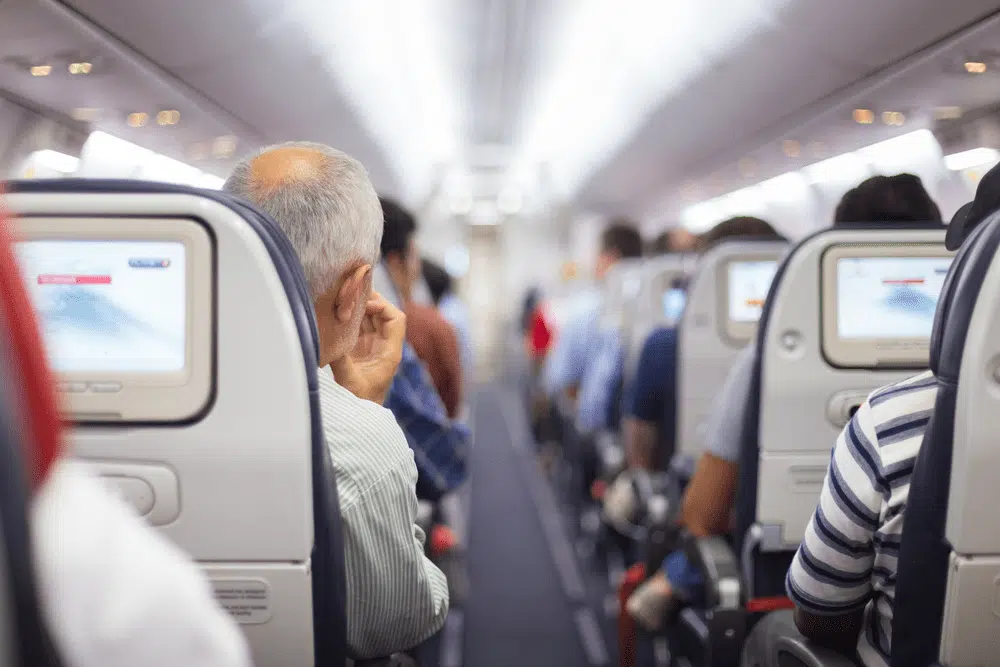Don’t miss out on spring break: with the right preparation, you can handle flying with chronic pain.
Airline seats are uncomfortable in the best of circumstances, but for someone experiencing chronic pain, specifically back pain, it can feel like an insurmountable obstacle to an enjoyable spring break vacation. Have you considered skipping the family trip or tropical vacation because you can’t imagine 4 hours on a plane? Learn some tips from the iSpine Clinics experts, and you’ll be warm weather or beachbound without worry.
4 Steps for Flying with Chronic Pain
Step 1: Be prepared, physically and mentally
As we now know, chronic pain is as much a mental issue as it is physical. It’s important to consider how both your body and your mind will handle this challenge. First, address your physical comfort: make sure you’re staying hydrated to keep your joints and muscles lubricated and protected. Bring an empty water bottle with you—you’ll be allowed to bring it through security, and you can fill it up once you’re on your way to your gate. Depending on your timing, you can challenge yourself to drink a certain amount before you board, and more once you’re en route.
You can also plan ahead to make your seat as comfortable as possible. Wear a sweatshirt, even in warm weather—you can use it as lumbar or cervical support by rolling it up and placing it behind your back. Customize your support by choosing a sweatshirt of varying thickness or changing the number of folds. There are also inflatable options you can purchase that provide comfort, but don’t require much packing space. Finally, remember that, when flying with chronic pain, fashion isn’t first! Wear clothes that won’t bunch or bind—mobility and comfort are key.
Mentally, you can minimize the stress of anticipatory and actual pain by utilizing your favorite things as distraction. Download your favorite podcast or audiobook you’ve been looking forward to, or build a travel playlist of music that soothes you. Brain puzzles like sudoku can refocus your mind on complex tasks—and give you the satisfaction of victory as you coast over the Midwest. Finally, meditation apps can be a very successful tool in harnessing your energy in a positive direction until you land.
Step 2: Waiting at your gate
You’ve planned ahead, but while you’re at the airport you can take some physical steps to help your body before takeoff. Here are some helpful stretches that will increase your mobility and comfort:
- Find a free bit of wall space (don’t lose sight of your bags!). Standing close to the wall, brace your hands or forearms and one foot against it, leaning forward to stretch your hamstring and calf. Alternate legs, then repeat, being mindful of your breathing for a deeper stretch.
- Once you’ve completed your posterior chain stretches, address the front of your legs. Being seated for an extended period of time can tighten up your quads. Using the same wall space, brace yourself for balance. Draw your right heal up towards your glutes, and place the top of the foot in your right hand. Use your hand to guide the heel as close as is comfortable to your body, while pressing down through the top of the foot into the hand.
- Don’t forget your upper body! Especially if you tend to fall asleep on planes, your neck and shoulders can suffer. Prepare your neck with a simple “forward/backward” stretch. For a count of 5, lower your chin to your chest until your head hangs with no resistance. Hold for another count of 5, then slowly raise back to neutral. From there, take another count of 5 to let your head lean back as far as is comfortable. Don’t force it beyond its natural stopping point, but when you’ve reached that spot, hold and breath through another five seconds. Repeat 5 times. If you’re comfortable, at the bottom of the forward neck roll, you can carefully and gently nod your head ‘yes and no’ to increase the stretch.
Step 3: You’re on your way!
Congratulations, you’re on the plane—one step closer to your vacation! At this point, you’ve taken a lot of proactive steps to make this trip as pain-free as possible. Remember to implement your physical and mental strategies throughout the flight—drink your water, adjust your seat support, and enjoy your podcast or music!
But when flying with chronic pain, it’s also important to move throughout your flight. Pay attention to the “Fasten Seatbelt” sign. Whenever it turns off, that’s a great opportunity for some quick movement. Stand up, go to the bathroom if necessary (remember your water challenge!), or even just get up and do one or two laps down the aisles. Getting your blood pumping and your joints re-lubricated will keep you comfortable longer.
Step 4: This is the captain speaking: we’re approaching our destination
The plane has landed, and you made it through! To ensure residual pain won’t set in after your flight (ruining any of your precious vacation time!), you’ll want to keep moving. Once you get off the plane, take a few extra minutes to go through another round of the pre-flight stretches. Your muscles and joints will thank you for the reawakening! And, even if you’re in a rush to unload at your hotel room and decamp on the beach, take your time walking to the baggage claim. Your body has been through quite the adjustment in temperature, pressure, and position, so be gentle with it as you acclimate. You may also be in a totally different climate, which can affect how you feel and function, so be mindful of your movement as you leave the building.
By being mindful of both your physical and mental well-being, you can successfully survive flying with chronic pain. A few easy steps to prepare yourself, plus minimal effort on your flight and when you land, will reduce your anticipatory stress and allow you to fully enjoy your spring break!
And remember: If you’re dealing with chronic back pain the team at iSpine Clinics is here to help. Call us at (7693) 201-8191 to schedule a consultation. With clinic locations across the Twin Cities metro area, we are proud to offer a wide range of pain relief and management services.


